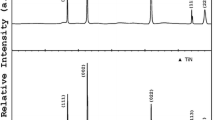Abstract
The air oxidation mechanism of nanocrystalline TiN at 500 to 900 °C is examined. It is shown that at t ≤ 800 °C the oxidation of titanium nitride is controlled by the diffusion of oxygen and at t > 800 °C the interdiffusion of titanium ions is observed. The oxidation properties of porous TiN are determined by the chemical interaction of oxygen and the reaction surface, which includes the external surface of samples and the internal surface of the pores into which oxygen penetrates. The time and temperature dependence of the weight increment complies with the porous material oxidation model. Active initial oxidation is due to the interaction of oxygen and large internal surface. Short-term self-heating of porous samples is also possible. At t ≤ 800 °C, the pores are obliterated with oxides with time, the internal reaction surface reduces, an external oxide film is formed, the oxygen diffusion and weight increment slow down, and the process stabilizes. With temperature increase, these processes are activated and lead to a smaller weight increment at the final stage (2 to 4 h) at 800 °C as compared with 600 °C. At t > 800 °C the pore obliteration rate increases, but due to the interaction of oxygen and titanium ions that diffuse into the external scale surface, weight increment continuously increases with both time and oxidation temperature. The phase composition of the scale also affects the oxidation mechanism of porous TiN. Oxynitride of terminal composition plays a protective role; the transformation of anatase into rutile is accompanied by a decrease in the oxygen diffusion rate; Ti2O3 formed in pores accelerates their obliteration.
Similar content being viewed by others
References
V. G. Chuprina, I. M. Shalya, and V. S. Zenkov, “Oxidation of porous nanocrystalline titanium nitride. I. Kinetics,” Powder Metall. Met. Ceram., 45, No. 1–2, 82–85 (2006).
I. M. Fedorchenko, F. P. Lyapunov, and V. V. Skorohod, “Phenomena taking place during oxidation of porous metals at elevated temperatures,” Powder Met., No. 12, 27–43 (1963).
É. T. Denisenko, “Macrokinetics of oxidation of porous substances,” Powder Metall. Met. Ceram., 3, No. 5, 386–390 (1964).
É. T. Denisenko and Yu. A. Panfilov, “Oxidation of porous bodies,” Powder Metall. Met. Ceram., 5, No. 10, 799–801 (1966).
V. G. Chuprina and I. M. Shalya, “Oxidation of porous nanocrystalline titanium nitride. II. Scale structure and composition,” Powder Metall. Met. Ceram., 45, No. 3–4, 168–172 (2006).
N. V. Fedoseev and O. G. Nemkova, “Dry and wet oxidation of titanium nitride,” Neorg. Khim., 7, No. 5, 980–982 (1962).
V. A. Zhilyaev, S. N. Alyamovskii, V. D. Lyubimov, and G. P. Shveikin, “Mechanism and kinetics of air oxidation of titanium nitrides and oxynitrides,” Izv. AN SSR. Neorg. Mater., 10, No. 12, 2151–2155 (1974).
G. D. Bogomolov, G. P. Shveikin, S. N. Alyamovskii, et al., “Physical and chemical properties of titanium oxynitrides and carbonitrides,” Izv. AN SSR. Neorg. Mater., 7, No. 1, 67–72 (1971).
Yu. G. Gogotsy, F. Porz, and G. Dransfild, “Oxidation behavior of monolytic TiN dispersed in ceramic matrices,” Oxidation Metals, 9, No. 1–2, 70–91 (1993).
F. F. Egorov and V. E. Matsera, “Oxidizability of cermets based on titanium nitride,” Powder Metall. Met. Ceram., 35, No. 3–4, 192–196 (1996).
R. F. Voitovich and É. A. Pugach, “High-temperature oxidation of the nitrides of the groups IV and V transition metals,” Powder Metall. Met. Ceram., 14, No. 7, 562–566 (1975).
V. A. Lavrenko and Yu. G. Gogotsi, Corrosion of Structural Ceramics [in Russian], Metallurgiya, Moscow (1989), p. 198.
Physical and Chemical Properties of Oxides: Handbook [in Russian], Metallurgiya, Moscow (1978), p. 470.
P. Kofstad, High Temperature Oxidation of Metals, J. Wiley & Sons, New York (1966).
É. T. Denisenko, “Spontaneous heating of porous materials during oxidation,” Powder Metall. Met. Ceram., 5, No. 7, 551–553 (1966).
A. S. Bai, D. I. Lainer, E. N. Slesareva, M. I. Tsipin, Oxidation of Titanium and Its Alloys [in Russian], Metallurgiya, Moscow (1970), p. 300.
V. G. Chuprina, “Examination of the process of oxidation of titanium nickelide. I. Kinetics,” Powder Metall. Met. Ceram., 28, No. 4, 310–314 (1989).
V. G. Chuprina, “A study of the process of oxidation of titanium nickelide. II. Phase composition of the scale,” Powder Metall. Met. Ceram., 28, No. 6, 468–472 (1989).
S. N. Alyamovskii, Yu. G. Zainulin, and G. P. Shveikin, Oxycarbides and Oxynitrides of Group IVA and VA Metals [in Russian], Nauka, Moscow (1981), p. 144.
S. N. Alyamovsky, E. N. Shchetnikov, and G. P. Shveikin, “Completeness of lattices of titanium and vanadium oxycarbides and oxynitrides,” Izv. AN SSSR, Neorg. Mater., 5, No. 7, 210–213 (1969).
A Handbook of Chemistry, Vol. 2 [in Russian], Khimiya, Leningrad-Moscow (1964), p. 1160.
Yu. D. Tret’yakov, Chemistry of Nonsteichiometric Oxides [in Russian], Izd. Moscow Univ., Moscow (1974).
V. G. Chuprina, I. M. Shalya, and I. I. Karpikov, “Reaction of the hydrogen-absorbing intermetallic compound TiFe with oxygen. III. Phase composition of the scale formed on TiFe,” Powder Metall. Met. Ceram., 34, No. 11–12, 663–668 (1995).
V. G. Chuprina, “Interaction of hydrogen-absorbing intermetallic compound TiFe with oxygen. IV. Mechanism of oxidation of TiFe,” Powder Metall. Met. Ceram., 35, No. 5–6, 290–295 (1996).
Author information
Authors and Affiliations
Additional information
__________
Translated from Poroshkovaya Metallurgiya, Vol. 46, No. 3–4 (454), pp. 95–104, 2007.
Rights and permissions
About this article
Cite this article
Chuprina, V.G. Oxidation of porous nanocrystalline titanium nitride. III. Oxidation mechanism. Powder Metall Met Ceram 46, 182–188 (2007). https://doi.org/10.1007/s11106-007-0029-1
Received:
Issue Date:
DOI: https://doi.org/10.1007/s11106-007-0029-1




